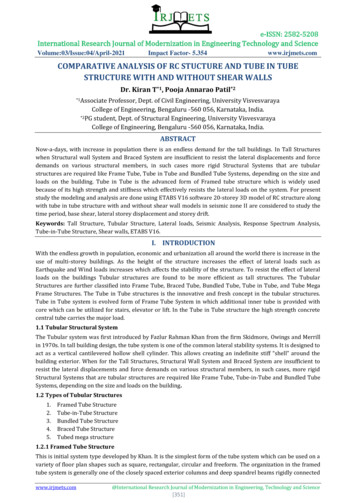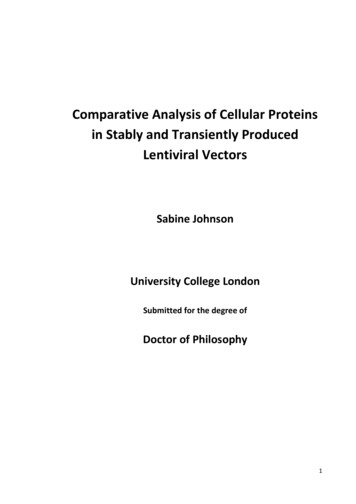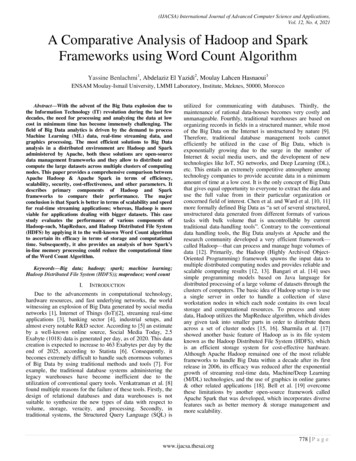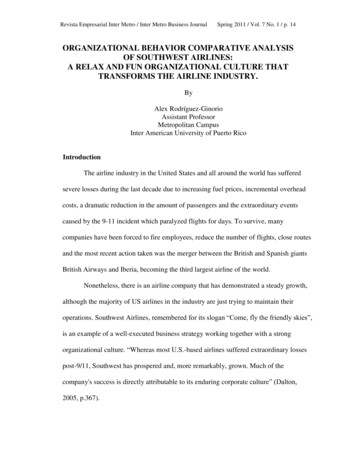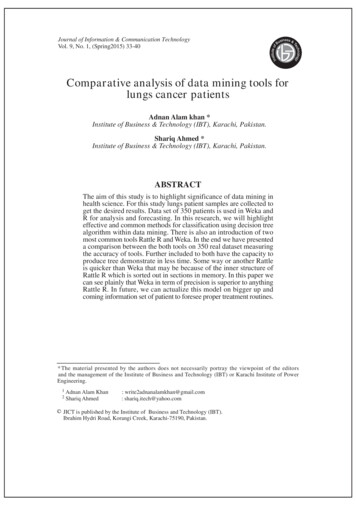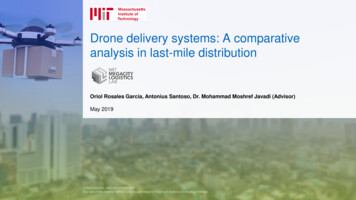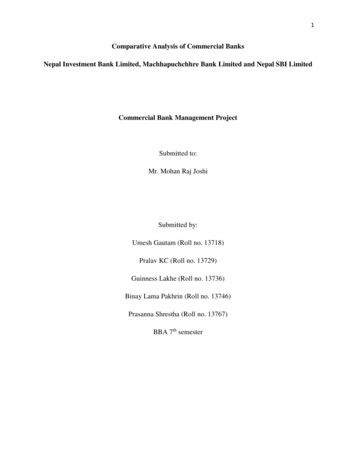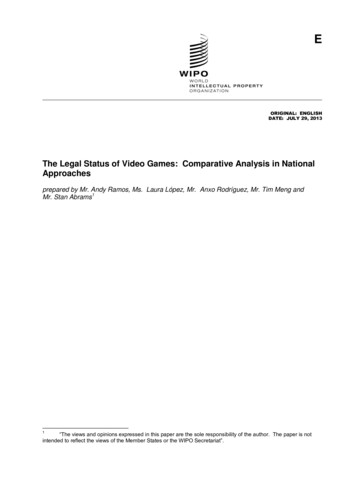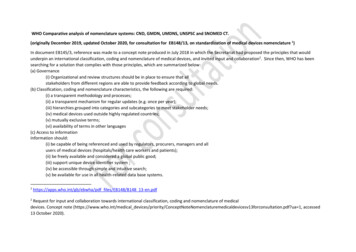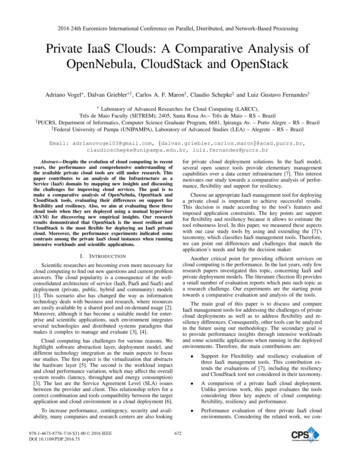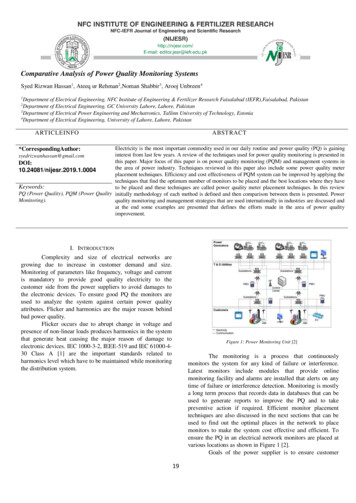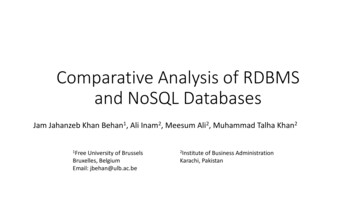
Transcription
Comparative Analysis of RDBMSand NoSQL DatabasesJam Jahanzeb Khan Behan1, Ali Inam2, Meesum Ali2, Muhammad Talha Khan21FreeUniversity of BrusselsBruxelles, BelgiumEmail: jbehan@ulb.ac.be2Instituteof Business AdministrationKarachi, Pakistan
Introduction (1/2) Big Data has been the subject of increased research since data has been termed the new oil for the 21stcentury Recently, smart grids have been used by energy providers to store the massive amount of data that isgenerated at regular time intervals We have obtained data from one such company that provides the residents of its City with electrical energy The company stores their data in a Not only Structured Query Language (NoSQL) database [1], since thesmart grid data has a high volume, accelerated velocity, and tremendous variety Hence, we feel that we can provide an important comparison of NoSQL tools using this data. NoSQL toolshave been actively used for storage purposes in the industry Companies like eBay, GitHub, and Amazon have been using these tools for storage and analytical purposesalike In this paper, we compare and analyze four different technologies: MySQL [2], MongoDB [3], MonetDB [4],and InfluxDB [5] using the data generated by the smart grids of KElectric
Introduction (2/2) The aim of this paper is to compare RDBMS and NoSQL technologies By analysing a relational data in a non-relational environment The company from which the data has been acquired uses MySQL as the main RDBMS technology for theirstorage and querying purposes
Data (1/2) The data comprises of meter readings from over 9000 smart meters spread throughout the city These smart meters are installed at consumer sites, on Pole Mounted Transformers (PMTs), and ondistribution feeders The data is initially stored in an internal buffer, of each respective meter. The device then communicateswith the server, based on configurable intervals (using the push/pull protocol) In case of any communication lapse, the infrastructure is designed to record the lost data over a period ofseven days The data is recorded in Head End, the objective of which is to acquire meter data and monitor deviceparameters automatically, thus avoiding any human intervention The data being utilized for this project is collected over a period of three months, with an uncompressed sizeof approximately 45 GB The devices installed at the consumers end generate data over a 30 minutes interval, while the devicesplaced on distribution assets generate data after every 15 minutes As a first step, we aimed to understand the data on hand by (i) manually looking at a smaller chunk ofmanageable data and by (ii) asking the domain experts. We also had regular meetings with the employees ofthe company
Data (2/2) Once the data was analyzed, we gained theunderstanding of the fields provided in the data We imported the original data from thedatabases to use the data for queryingpurposes and then evaluate the queryexecution times Some fields have been highlighted as anessential part of the analysis. However, weomitted the fields: Description, Status,MeasuredUnit, and Scalar since these columnsdid not provide any information relevant to ouranalysis Moreover, a new field by the name ofTimestamp was created by concatenation ofthe Time and Date fields
MongoDB In MongoDB, the data is stored in flexible, JavaScript Object Notation (JSON) like documents Fields can vary from document to document and data structure can be changed over time Ad hoc queries, indexing, and real-time aggregation provide powerful ways to access and analyze the data A distributed database, so high availability, horizontal scaling, and geographic distribution are built-in andeasy to use while providing querying and indexing Functionalities We have selected MongoDB because it contains the best mixture obtained from RDBMS and NoSQLtechnologies It provides the data model flexibility, elastic scalability, and high performance of NoSQL databases whilescaling on commodity hardware [6].
InfluxDB It is an open-source time-series database that is optimized for fast, high-availability storage, and retrieval oftime series data It has no external dependencies and provides an SQL-like language with built in time-centric functions forquerying Each point consists of several key-value pairs called the field set and a timestamp A series is defined when a set of key-value pairs are grouped together Finally, series are grouped together by a string identifier to form a measurement Points are indexed by their time and tag set Retention policies are defined on measurement and control of how data is down sampled and deleted Continuous queries run periodically, storing results in a target measurement.
MonetDB It is an open-source column-oriented database management system designed to provide high performanceon complex queries against large databases, such as combining tables with hundreds of columns andmillions of rows Its architecture is represented in three layers, each with its own set of optimizers The front-end provides a query interface for SQL, where queries are parsed into domain-specificrepresentations, like relational algebra for SQL, and optimized. The middle or back-end layer provides several cost-based optimizers The bottom layer is the database kernel, which provides access to the data stored in Binary AssociationTables, where each table consists of an Object-identifier and value columns, representing a singlecolumn in the database Internal data representation also relies on the memory addressing ranges of contemporary CPUs usingdemand paging of memory mapped files and, thus, departing from traditional DBMS designs involvingcomplex management of large data stores in limited memory We have selected MonetDB because it has been designed to provide high performance on complex queriesagainst large databases and also because it has been applied in high-performance applications for betteranalytics
Queries, Results, and Conclusion We have written queries of different categories for each database and ranthem on the AWS instances. Due to their complex nature, we were unableto perform UNION queries for MongoDB and InfluxDB [7]. The queriesbelong to one of the following categories:1.2.3.4.5.Simple QueryRange QueryAggregated QueryNested QueryUNION Query To provide an unbiased experimental runtime, the repeated theexperiments 10 times. As it can be seen from the table, all the technologieswere able to obtain the same results (in terms of the number of records)for identical queries. Hence, we compare the results based on theRuntime(s) columns in the table that correspond to the average time takento obtain the results while computing on the given technology instance The results obtained from MySQL serve as a baseline for the NoSQLtechnologies, and it is safe to say that all the NoSQL technologies were ableto obtain better results than the baseline. It can be observed thatMonetDB was able to outperform MySQL and was still able to provideresults for all categories of queries. It is also worth mentioning thatInfluxDB outperformed all the systems in terms of computational time
Related Work Hadjigeorgiou et al. [8] have compared the performance of MongoDB and MySQL when they are scaled and sharded.They conclude that the most important factor was the query type used as MongoDB handled more complex queriesfaster, due mainly to its simpler schema and performed better during insertions. MySQL performs better when deletingdata since it performs better in simple search queries. The authors highlight that both databases have had a linear trendin the benchmarks Ansari et al. [9] selected Hbase, MongoDB, Cassandra, and Elasticsearch NoSQL technologies and compared them usingstructural column-based data from smart grids. They compared the databases on effectiveness and scalability. Theresults showed that Cassandra had the smallest average latency in both read and write processes Venkatraman et al. [10] discussed the four main data models of non-relational databases and compared them to SQLdatabases. They state that Couchbase processes more operations per second with lower average latency in reading andwriting data than both MongoDB and Cassandra. Also, Cassandra is faster in writing than MongoDB, however, both havealmost equal reading speed. The authors conclude that the flexible data modeling of NoSQL is well suited to supportdynamic scalability and improved performance for Big Data analytics Santos et al. [11] have used Geographic Information Systems (GIS) data to compare PostGIS, MongoDB, and Neo4jSpatial. The authors have performed different types of operations, where each operation contains a group of queries.Even though all groups include 20 parameterized queries, the parameter values vary within predefined ranges for eachgroup. In the conclusion, the authors have highlighted that, since the spatial attributes are much more complex tohandle as compared to strings, numbers, and other relational data types, evaluating and benchmarking spatial DBMSperformances is not as simple as doing so in RDBMS
References1.S. Edlich, “Your Ultimate Guide to the Non-Relational Universe!” http://nosql-database.org/, [Online; accessed April 23rd, 2020]2.Oracle Corporation, “MySQL,” https://www.mysql.com/, [Online; accessed April 23rd, 2020]3.MongoDB, Inc., “MongoDB,” https://www.mongodb.com/, [Online; accessed April 23rd, 2020]4.MonetDB B.V., “MonetDB,” https://www.monetdb.org/Home, [Online; accessed April 23rd, 2020]5.InfluxData Inc, “InfluxDB,” https://www.influxdata.com/, [Online; accessed April 23rd, 2020]6.C. Kristina and D. Michael, “MongoDB: The Definitive Guide,” 20107.Joson Morn, “Issues with InfluxDB,” https://groups.google.com/forum/msg/ influxdb/jGVE3uDStNg/9KYxjY46AQAJ, [Online;accessed April 23rd, 2020]8.C. Hadjigeorgiou et al., “RDBMS vs NoSQL: Performance and Scaling Comparison,” MSc in High, 20139.M. H. Ansari, V. T. Vakili, and B. Bahrak, “Evaluation of big data frameworks for analysis of smart grids,” J. Big Data, vol. 6, 2019,p.10910.S. Venkatraman, K. Fahd, S. Kaspi, and R. Venkatraman, “SQL versus NoSQL movement with Big Data Analytics,” InternationalJournal of Information Technology and Computer Science, vol. 8, no. 12, 2016, pp. 59–6611.P. O. Santos, M. M. Moro, and C. A. D. Jr., “Comparative Performance Evaluation of Relational and NoSQL Databases for Spatialand Mobile Applications,” in Database and Expert Systems Applications - 26th International Conference, DEXA 2015, Valencia,Spain, September 1-4, 2015, Proceedings, Part I, ser. Lecture Notes in Computer Science, Q. Chen, A. Hameurlain, F. Toumani, R.R. Wagner, and H. Decker, Eds., vol. 9261. Springer, 2015, pp. 186–200.
Ansari et al. [9] selected Hbase, MongoDB, Cassandra, and Elasticsearch NoSQL technologies and compared them using structural column-based data from smart grids. They compared the databases on effectiveness and scalability. The results showed that Cassandra had the smallest average latency in both read and write processes Venkatraman et al. [10] discussed the four main data models of .

